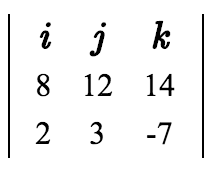What is the unit vector that is orthogonal to the plane containing # (8i + 12j + 14k) # and # (2i + 3j – 7k) #?
1 Answer
Explanation:
A vector which is orthogonal (perpendicular, norma) to a plane containing two vectors is also orthogonal to the given vectors. We can find a vector which is orthogonal to both of the given vectors by taking their cross product. We can then find a unit vector in the same direction as that vector.
Given

For the
#(12*-7)-(14*3)=-84-42=-126#
For the
#-[(8*-7)-(2*14)]=-[-56-28]=84#
For the
#(8*3)-(12*2)=24-24=0#
Our normal vector is
Now, to make this a unit vector, we divide the vector by its magnitude. The magnitude is given by:
#|vecn|=sqrt((n_x)^2+(n_y)^2+(n_z)^2)#
#|vecn|=sqrt((-126)^2+(84)^2+(0)^2)#
#|vecn|=sqrt(15878+7056+0)=sqrt(22932)=42sqrt(13)#
The unit vector is then given by:
#vecu=(vecaxxvecb)/(|vecaxxvecb|)#
#vecu=(< -126,84,0 >)/(42sqrt(13))#
#vecu=1/(42sqrt(13))< -126,84,0>#
or equivalently,
#vecu=< -3/(sqrt(13)),2/(sqrt(13)),0>#
You may also choose to rationalize the denominator:
#vecu=< (-3sqrt(13))/13, (2sqrt(13))/13, 0 >#

